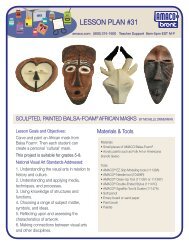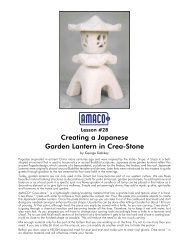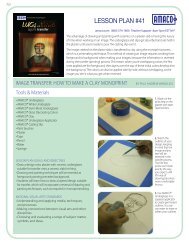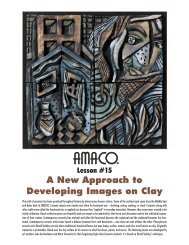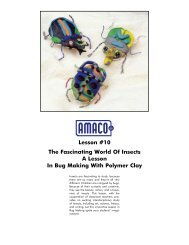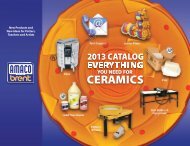LESSON PLAN #39 - Amaco
LESSON PLAN #39 - Amaco
LESSON PLAN #39 - Amaco
Create successful ePaper yourself
Turn your PDF publications into a flip-book with our unique Google optimized e-Paper software.
<strong>LESSON</strong> <strong>PLAN</strong> <strong>#39</strong><br />
amaco.com (800) 374-1600 Teacher Support 8am-5pm EST M-F<br />
Overglaze Decoration on Tiles<br />
History/Background: “Majolica” is the historical term used<br />
to describe this decorative glaze-on-glaze process.<br />
Developed on an island off of Spain and refined in Italy,<br />
“Majolica” is the decorative ceramic technique of completely<br />
coating your ware in an opaque white glaze, then decorating<br />
on top of that glaze with decorative stains and oxides.<br />
FaIence (or Faenza) and Delft pottery also employ the same<br />
technique as Majolica (Maiolica). AMACO’s low-fire LG-11<br />
Opaque White glaze and Gloss Decorating Colors (GDC’s),<br />
allow you to mimic this historic technique with ease and<br />
success.<br />
Objective: Students will learn how to replicate the historic<br />
ceramic decoration technique of “Majolica” using AMACO ®<br />
GDC's and AMACO ® low-fire Gloss Glazes.<br />
This technique is suitable for all grades.<br />
National Visual Art Standards Addressed:<br />
1. Understanding the visual arts in relation to history and culture.<br />
2. Understanding and applying media, techniques, and<br />
processes.<br />
3. Using knowledge of structures and functions.<br />
4. Choosing a range of subject matter, symbols and ideas.<br />
5. Reflecting upon and assessing the characteristics of artwork.<br />
6. Making connections between visual arts and other disciplines.<br />
Materials & tools<br />
By Chad Chriscinske<br />
• AMACO ® GDC’s<br />
• AMACO ® Gloss<br />
Glazes – LG-11 White, DG-1<br />
Black Lacquer<br />
• Bisque Tiles<br />
• Glazed Tiles<br />
• Paint Brushes
Technique:<br />
Majolica Tiles:<br />
1. Coat half of the 6" x 6" tile in LG-11 Opaque W hite glaze and<br />
the other half in DG-1 Black Lacquer and set aside to dry.<br />
2. Show your students images of both historical Majolica wares<br />
and contemporary ceramic artists who use the Majolica<br />
process. Allow them to discuss the similarities and differences<br />
found in both.<br />
• Bright Colors, Image content, Wares, Functional vs. Decorative.<br />
3. Have your students sketch out a few possible designs or<br />
motifs that they want to use for the Majolica technique.<br />
Possibly create one contemporary design and one that mimics<br />
the more historical/classical Majolica style.<br />
4. Have them decorate using the Majolica technique on both<br />
the glazed and fired tile and the bisque tile that has been<br />
glazed half white and half black.<br />
5. Fire to a witness cone 05 and discuss the results.<br />
Additional Information: AMACO ® GDC’s are<br />
formulated specifically for this process. They are designed<br />
to act more stiff when fired therefore detailed line work<br />
and decoration is not lost. They are not only effective for<br />
Majolica but are also versatile enough to be used as an<br />
underglaze, as cone 5/6 Majolica and as a decorative<br />
glaze on top of a matte glaze.<br />
4<br />
1<br />
2<br />
3<br />
By Linda Arbuckle<br />
5<br />
For more lesson plans ideas, visit amaco.com





